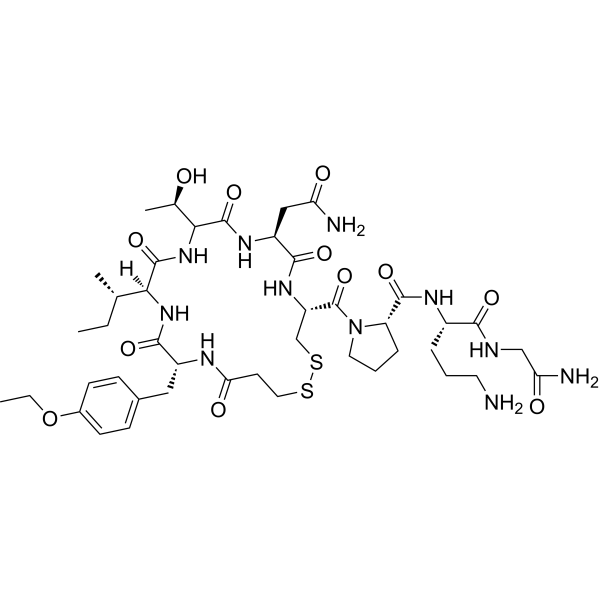| Synonyms: |
Atosiban;1-deamino-2d-tyr-(oet)-4-thr-8-orn-oxytocin;oxytocin,1-(3-mercaptopropanoicacid)-2-(o-ethyl-d-tyrosine)-4-l-threonine-8-l;rwj22164;ATOSIBAN ACETATE;1-(3-Mercaptopropionic acid)-2-(3-(p-ethoxyphenyl)-D-alanine)-4-L-thre onine-8-L-ornithineoxytocin;[Mpr-D-Tyr(OEt)-Ile-Thr-Asn-Cys]-Pro-Orn-Gly-NH2;(2S)-N-[(1S)-4-Amino-1-(carbamoylmethylcarbamoyl)butyl]-1-[(4S,7S,13S,16R)-13-[(2S)-butan-2-yl]-7-(carbamoylmethyl)-16-[(4-ethoxyphenyl)methyl]-10-(1-hydroxyethyl)-6,9,12,15,18-pentaoxo-1,2-dithia-5,8,11,14,17-pentazacycloicosane-4-carbonyl]pyrrolidine-2-carboxamide;1-(3-Mercaptopropanoic acid)-2-(O-ethyl-D-tyrosine)-4-L-threonine-8-L-ornithineoxytocin;(Deamino-Cys1,D-Tyr(Et)2,Thr4,Orn8)-Oxytocin;1-Deamino-2-D-Tyr-(O-ethyl)-4-Thr-8-ornoxytocin;RW22164;Tractocile;(2S)-N-[(1S)-4-Amino-1-(carbamoylmethylcarbamoyl)butyl]-1-[(4S;Antocin;Rwj 22164;dTVT;081D12SI0Z;Atosibanum [INN-Latin];deTVT;Atosibanum;ORF 22164;Antocin II;Atosiban [USAN:INN:BAN];1-(3-Mercaptopropionic acid)-2-(3-(p-ethoxyphenyl)-D-alanine)-4-L-threonine-8-L-ornithineoxytocin;C43H67N11O12S2;1-(3-Mercaptopropanoic acid)-2-(O-ethy;1,2-Dithia-5,8,11,14,17-pentaazacycloeicosane, cyclic peptide deriv. (ZCI);Oxytocin, 1-(3-mercaptopropanoic acid)-2-(O-ethyl-D-tyrosine)-4-L-threonine-8-L-ornithine- (ZCI);Antocile;CAP 449;CAP 476;CAP 581;F 314;RW 22164;DTXSID90861122;CAS_90779-69-4;(2S)-N-[5-amino-1-[(2-amino-2-oxoethyl)amino]-1-oxopentan-2-yl]-1-[(4R,7S,16R)-7-(2-amino-2-oxoethyl)-13-[(2S)-butan-2-yl]-16-[(4-ethoxyphenyl)methyl]-10-[(1R)-1-hydroxyethyl]-6,9,12,15,18-pentaoxo-1,2-dithia-5,8,11,14,17-pentazacycloicosane-4-carbonyl]pyrrolidine-2-carboxamide;AKOS015895131;MFCD00672436;NCGC00387803-01;BCP02053;1-[7-(2-Amino-2-oxoethyl)-13-(butan-2-yl)-16-[(4-ethoxyphenyl)methyl]-10-(1-hydroxyethyl)-6,9,12,15,18-pentaoxo-1,2-dithia-5,8,11,14,17-pentaazacycloicosane-4-carbonyl]prolylornithylglycinamide;SY301205;BDBM86209;90779-69-4;CAP-476;CAP-476;CAP-476;CAP-476;CAP-476;ATOSIBAN (MART.);ATOSIBAN (MART.);ATOSIBAN (MART.);ATOSIBAN (MART.);ATOSIBAN (MART.);d(D-Tyr(Et)2,Thr4,Orn8)vasotocin;d(D-Tyr(Et)2,Thr4,Orn8)vasotocin;d(D-Tyr(Et)2,Thr4,Orn8)vasotocin;d(D-Tyr(Et)2,Thr4,Orn8)vasotocin;d(D-Tyr(Et)2,Thr4,Orn8)vasotocin;RW22164;RWJ22164;RW22164;RWJ22164;RW22164;RWJ22164;RW22164;RWJ22164;RW22164;RWJ22164;C77085;C77085;C77085;C77085;C77085;CAS-90779-69-4;CAS-90779-69-4;CAS-90779-69-4;CAS-90779-69-4;CAS-90779-69-4;Atosibanum (INN-Latin);Atosibanum (INN-Latin);Atosibanum (INN-Latin);Atosibanum (INN-Latin);Atosibanum (INN-Latin);(Deamino-Cys1,D-Tyr(Et)2,Thr4,Orn8)-Oxytocin acetate salt;(Deamino-Cys1,D-Tyr(Et)2,Thr4,Orn8)-Oxytocin acetate salt;(Deamino-Cys1,D-Tyr(Et)2,Thr4,Orn8)-Oxytocin acetate salt;(Deamino-Cys1,D-Tyr(Et)2,Thr4,Orn8)-Oxytocin acetate salt;(Deamino-Cys1,D-Tyr(Et)2,Thr4,Orn8)-Oxytocin acetate salt;DTXSID8048991;DTXSID8048991;DTXSID8048991;DTXSID8048991;DTXSID8048991;GTPL2213;... |

 To enhance service speed and avoid tariff delays, we've opened a US warehouse. All US orders ship directly from our US facility.
To enhance service speed and avoid tariff delays, we've opened a US warehouse. All US orders ship directly from our US facility.




















